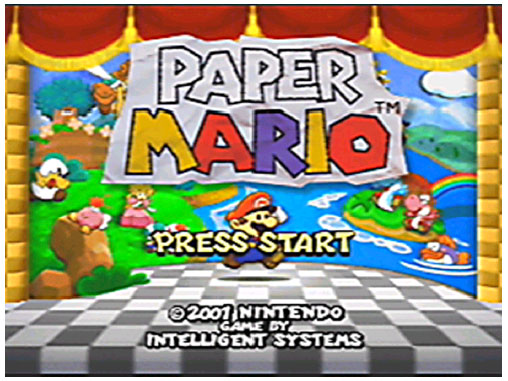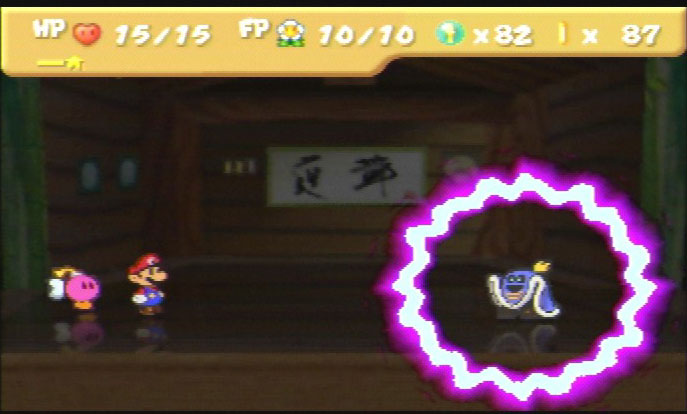 |
Paper Mario - Review |
 |
Best N64 RPG past, present and, barring divine intervention,
future
By: Ashgad
| Review Breakdown |
| Battle System |
10 |
| Interface |
9 |
| Music/Sound |
10 |
| Originality |
8 |
| Plot |
6 |
| Localization |
10 |
| Replay Value |
8 |
| Visuals |
10 |
| Difficulty |
Easy |
| Time to Complete |
20 - 25 hours
|
|
| Overall |
 |
| Criteria
|

|
| |
Sometimes RPGs frighten me. So many times I'll get a new game, only to be
disappointed that the developer strived a little too hard to emulate
"realism." This usually means that I must endure "attitude"-laden
characters, grey-soaked environments featuring pseudo-technological
monsters, and, of course, hilariously out-of-place cuss words sprinkled
liberally in the dialogue and cutscenes. This is one of the main reasons
Paper Mario is so refreshing to me: it's a game that's both whimsical and
enjoyable, straightforward and involving, and, most importantly, a game that
is simply fun to play. Published by Nintendo and developed by the legendary
Intelligent Systems (formerly called R&D1, makers of Metroid, Super Metroid,
and Fire Emblem), Paper Mario delivers a fresh experience on almost every
level. Combat, interface, music, plot, graphics- it's all here, and it's
all done so well that I'm inclined to forgive the N64's barren RPG history.
The combat in Paper Mario is pretty much nothing like anything else you'll
find for sale today. Throw out your Final Fantasy-indoctrinated notions of
dealing multiple thousands of damage points per round: Paper Mario never,
ever deals in numbers much larger than 10 (and above 7 is rare). While it
takes some time to get used to always dealing one damage with a basic
attack, the system is well-balanced. Returning from Super Mario RPG is the
concept of "Action Commands," i.e. executing a controller move Street
Fighter-style at the right time to double Mario's damage, increase his
defense, etc. Unlike its SNES predecessor, Paper Mario's sidekicks don't
actually participate in combat in the traditional Final Fantasy sense.
Mario can have out one at a time to contribute with unique attacks, but it's
always the poor ol' plumber who takes all the hits. While Paper Mario's
combat system is a huge departure from traditional RPGs, it's brilliantly
executed and vast fun to master. The game also starts off with a good
tutorial to ease players into the fun.
The non-combat interface of Paper Mario is well-executed, if not innovative
and intriguing like the combat. All the windows are competently designed
and easily accessed. The only real complaint is the clutter of badges that
Mario builds up as the game progresses. The narrow View All Badges window
gets somewhat difficult to navigate later on in the game. Aside from that
minor foible, the interface is golden.

|
| Cute? Nah...
|
|
Those who loved the music in the old, old Super Mario 2 (I am one of these
people) are in for a special treat with Paper Mario. Most of the songs are
written in a style combining Mario 2 with the SNES's Super Mario World. The
effect is perfect in combination with the "paper" characters and fast-moving
gameplay; it conveys an atmosphere not quite retro, not just a little
carefree, and definitely different from the overly moody, melodramatic
scores most modern RPGs tote. Bowser also finally gets a theme that
actually conveys his character. It's about time- Bowser's theme in Mario 64
sucked.
Paper Mario screams originality. It's a modern game with impressive 3D
environments and 2D sprites for all the characters. It features a combat
system unlike anything else around. Its music stands out as airy and
enjoyable, rather than moody and angst-ridden. The only area of weakness is
the simple, predictable plot.
Paper Mario's plot is, admittedly, a total, unrepentant rehash. Bowser
steals the magical Star Rod to become invincible, then imprisons the wise
but meddlesome Star Spirits and gives one to each of his top lieutenants.
This is the sort of plot Nintendo has been doing for years, following the
basic format: [Villain] steals [artifact] to conquer [kingdom]. [Hero] must
collect [another artifact], scattered in [number from 3 to 10] pieces
throughout [kingdom]. As an afterthought, [Princess] is a captive of
[villain]. Some gamers are undoubtedly growing tired of this storyline.
Fortunately, Paper Mario injects some life through liberal application of
sub plots and the wacky antics of characters such as Professor Kolorado, the
Koopa archeologist, and Herringway, the penguin mystery novelist (no, I did
not make those characters up).
Having suffered my way through the dialogue in Ocarina of Time AND Majora's
Mask, I was expecting to be somewhat let down by the translation of Paper
Mario, as is custom with Nintendo games. Incredibly, this did not happen.
The translators on this project did a terrific job: characters' lines are
logical, colorful, sport character-specific mannerisms, and are never
difficult to understand. Grammatical errors are unheard of.

|
| Yes, there's a dojo. Yes, you can fight someone named Chan there.
Also Lee. |
|
Perhaps I'm just strange, but having finished the game once, I have already
come up with a dozen reasons I want to play through again. Whether to
experiment with some different stats combo, to try to complete a certain
side-quest, or just to see the "Penguin Pop" song that I can't see anymore
at the end of the game, there's a lot to go back for. The game has
impressive depth for a cartridge. There may not be quite so many hidden
items and obscure secrets to search for as in many CD-based RPGs, but
there's plenty to look for if you're into that sort of thing.
The visuals... are amazing. Paper Mario sports the best, or at least the
most stylish, graphics I've seen in a console RPG in a very long time. The
actual sprites are well-drawn and animated, and all are consistent in style
with each other. The way buildings in town "fold out" creates a strong
sense of playing in a moving storybook, and the way the characters flip as
they turn and waft gently as they fall great distances adds to the concept.
Battle animations are suitably outrageous, with giant hammers and frequent
"squash you flat" attacks. Paper Mario also stands out in the subtle
touches it applies to its environments: Mario leaves footprints in the
desert and the snowy mountains, a knee-deep sea of blossoms leaves trails
behind your movement in the Flower Fields, and the magma inside Lavalava
Volcano is exceptionally well-rendered and animated. More importantly, all
these elements blend together seamlessly to create one graphical experience
that surpasses anything before seen on the N64.
Paper Mario is not hard. It's not quite a game you can sleep-walk through,
and battles demand concentration due to the action command system, but an
experienced gamer should have few problems defeating Bowser. This ease and
the cuteness of Paper Mario's characters may lead some to believe this is a
child's game. Don't be fooled. To dismiss Paper Mario as a game for little
kids is a tremendous injustice.

|
| That mean ol' Bowser. At least his music is cool now, though. |
|
To actually complete the game, fast gamers should only need around 20 hours.
To find every item, see every line of dialogue, and complete every
subquest, the intrepid gamer will need far more time. Most players will be
left wanting more.
Paper Mario is a triumph for Nintendo on many levels: it breaks modern RPG
conventions in atmosphere and tone, finally gives the N64 a Must Have! game
for RPG players, and, most importantly, gives us, the gamers, a game that is
both highly original and thoroughly enjoyable. Years from now, we'll be
looking back through our old games and, amid the sea of CDs, DVDs, and
GD-ROMs, we'll come across a lone cartridge featuring a cartoon Mario and
Bowser. I really hope we don't think to ourselves "Why don't they make
games like this anymore?"
|










